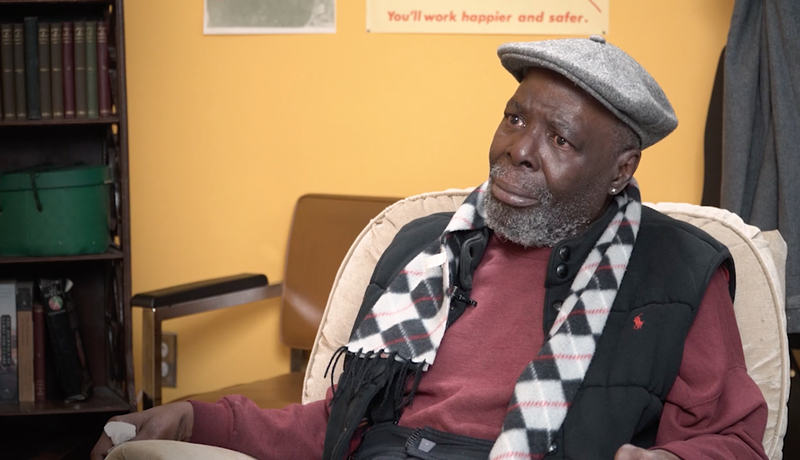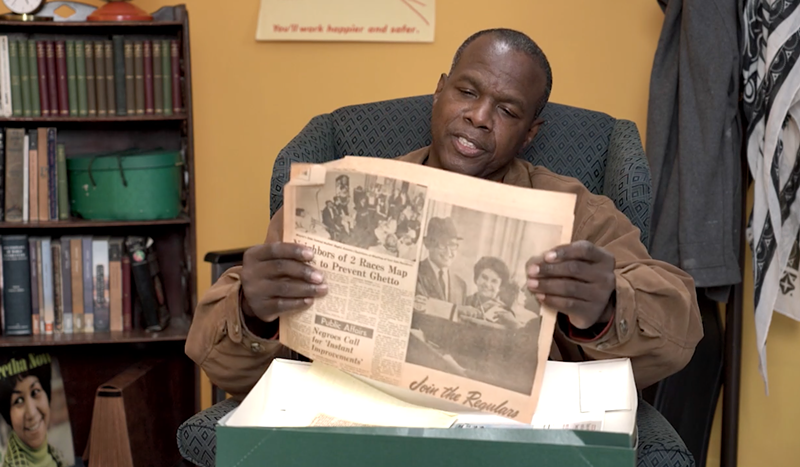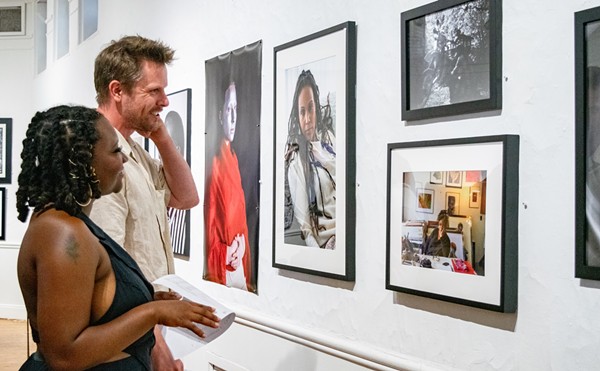
Screenshot
One of the children of Action House, Kevin George, tears up while discussing how Sarah E. Ray impacted his childhood.
“Come on over to the Action House. Come on over where the action is,” an elderly male sings jovially as he reminisces about his childhood.
Action House was the place to be in the east side Detroit neighborhood on Woodlawn Street in the '70s. The nonprofit community center promoted racial unity and youth empowerment with classic programs like neighborhood swim mobiles and free lunches.
It’s a little-known piece of Detroit history during a time when racial segregation permeated Detroit neighborhoods, leaving Black families separate from and unequal to their white counterparts.
But the roots of the page in this obscure history book run deeper. The woman who ran Action House, Lizz Haskell, also known as Sarah E. Ray, helped desegregate the famed Boblo boats and Detroit schools in her neighborhood.
Ray changed her name after marrying Jewish activist Rafael Haskell in the '60s, and many don’t realize they were the same person. The civil rights leader is often referred to as “Detroit’s other Rosa Parks” since she never rose to Parks’s notoriety, despite spearheading equally important work.
Ray is finally getting her flowers through the Sarah E. Ray Project, helmed by documentary filmmaker Aaron Schillinger and author Desiree Cooper (who used to be editor-in-chief of Metro Times). Schillinger and Cooper spent months working with community organizations and residents on a documentary project called The Children of Action House Oral Histories, where the now-adults who grew up attending the youth center shared memories of Ray.
The oral histories are separated into several short episodes, some of which were screened at the Woodlawn Family Affair Association’s block party in late August. Episodes in the video series open with Kevin George, one of the children of Action House, reciting the organization’s theme song, which he remembers Ray driving around the neighborhood and singing with a bullhorn.
George’s eyes light up as he laughs in delight when the interviewer pulls out the lyrics to the Action House song. He had forgotten the words, but they were recovered during an excavation of Ray’s now derelict house. The abandoned house still sits next to an empty lot where Action House once stood and the Detroit Land Bank Authority is looking for a buyer to preserve the historical landmark.
George said a nearby playground that Ray helped develop for the neighborhood children was his place of solitude during troubled times at his family home. He remembers having to play basketball in the dirt before Ray got asphalt laid and eventually secured a second rim.
“To know as a Black man that we count, [that] we don’t have to play basketball on the dirt,” he said, tearing up. “We can get new swings. I didn't know how to do that, but Lizz did… and I’m very thankful. I didn’t know that lady, but a stranger was nice to me. She was nice to a lot of people.”
Rochelle Wilson, who conducted the interviews for the series, also grew up in the neighborhood. Her father’s mother lived on Woodlawn, the same street as Action House, and she remembers going there as a child.
When she was young, Wilson, who is now in her 40s, thought Action House was run by the Black Panthers.
“In my era growing up, you seen Black Panthers giving out food and doing things for the community so to find out it was just Miss Lizz and her husband, it was like wow,” Wilson tells us.
She didn’t know Lizz Haskell was the same woman who desegregated the Boblo boat. In fact, as a young girl, Wilson was convinced she would get married on the boat.
“I just knew my children’s birthdays were gonna be on the Boblo boat, like I had all this planned out as a kid,” Wilson says. “And when it closed, I was like, ‘Where am I supposed to get married?’ And then to find out that we would have never been able to go there if it wasn’t for Miss Lizz was just…”
Through the interviews, Wilson learned that Ray also campaigned to desegregate the school she attended as a young girl, Pulaski Elementary Middle School.
“I’m like, ‘Did this lady ever stop?’ She was amazing, and we don’t even know these stories,” Wilson says. “She had meetings at the Action House and she took a group of parents up to Lansing to let them know there were schools over here that the children in the neighborhood couldn’t go to. They had to be bussed to schools on the west side. She fought for the children to go to the neighborhood schools and won. I would have never been able to go to that school if it weren’t for her.”

Screenshot
Sarah E. Ray’s great grand nephew Kourtney Thompson looks at a newspaper clipping about Action House from 1968.
Kourtney Thompson is Ray’s great grand nephew. He said in his episode of the documentary that he visited “Aunt Lizz” as a young boy but didn’t know the depth of her legacy until he read Cooper’s 2006 column about Sarah E. Ray in the Detroit Free Press.
“I knew about Action House and that kind of thing but I didn’t know the weight of what she was involved in with the Boblo boat case,” he said.
That case would set the precedent for the landmark Brown v. Board of Education decision, which ruled segregation in public schools was unconstitutional.
In his episode, Thompson shares several documents that were recovered from Ray’s home, including a 1968 Detroit News clipping about Action House.
“She was a formidable woman. I think she had to be to live and to take on the issues that she was taking on,” he said. “I think she carried herself in a way in which people paid attention. When she spoke, people listened. It wasn’t just an occupation, it was a way of life. She made a home for people. I mean, she literally lived next door to this place.”
Thompson poured his aunt Lizz’s ashes in the Detroit River along the Canadian side of Belle Isle, a fitting return to the place where her fight for integration began on the Boblo ferry S.S. Columbia in 1945.
The history books are now being rewritten to add Ray’s story as a chapter in the movement toward Black liberation and racial unity.
“Hopefully her story can serve as an example for others to be more active in the communities from which they come,” he said. “And that goes for me as well as really anybody because it is going to take the people in the community to make their communities better… Nobody is coming from outside to save you.”
Episodes of The Children of Action House Oral Histories will be released on the Sarah E. Ray Project’s website weekly. There are 10 episodes in total, with each one clocking in around six minutes.
Published in partnership with BridgeDetroit.
Stay connected with Detroit Metro Times. Subscribe to our newsletters, and follow us on Google News, Apple News, Twitter, Facebook, Instagram, Reddit, or TikTok.






